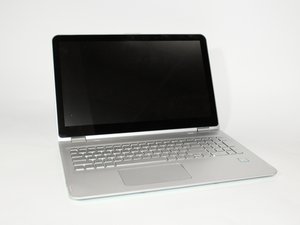Wiki con Collaborazione Studenti
Un fantastico team di studenti del nostro programma educativo ha realizzato questo wiki.
Screen is Blank
The screen is black or blank. Nothing is displayed on the screen when you press the power button.
Failure to Boot Up Properly
Reset the laptop to see if this fixes the blank screen. To do this, press and hold the power button until the device turns off. Release the button once the device is off. Wait 15 seconds. Next, press and hold the power button until the device turns on, and a picture is displayed on the screen.
Faulty Battery
If resetting the device does not work. You may need to replace the faulty battery. A link to the battery replacement guide can be found here.
Device Crashes Frequently During Usage
During normal use, the computer unexpectedly displays an error screen then shuts off.
Outdated Operating System/Software
Click the Windows icon in the bottom left corner of the home screen, a menu will appear, click the gear icon to open settings. In the search bar, type “updates”; click the option “check for updates”. If an update is needed, you will be prompted with the option to “Restart Now”. Select this option and the device will complete the updates.
Disk Cleanup Required
Click on the File Explorer (yellow folder) icon on the bottom of the screen, right-click on “C:” which can be found by scrolling on the left side of the file explorer menu. A small menu will pop-up, select “Properties,” click on “Disk Cleanup” to perform a disk cleanup.
Need to Replace Memory (RAM)
If the other solutions do not work. A memory replacement may need to be performed. A link to the memory replacement guide can be found here.
Audio is Distorted or Contains Scratchy Noises
When using your laptop with audio, you hear a scratchy, buzzing noise in the sound. The audio distortion may be continuous or spontaneous.
Outdated Audio Drivers
Manufacturers are often updating their product’s drivers, and audio issues may be a result of your drivers not being up to standard. If you don’t know your audio driver’s manufacturer, you can find the information in the device manager program. This can be accessed through searching for it on your device’s search function, and the audio information will be under a “sound” tab. You can then visit the manufacturer’s website to download drivers specific to the one you have. A restart of the device may be required after driver installation completes.
Loose Cord/Cables
If you have a plug-in microphone or headphones for your device, the cables may not be properly connected with the device’s audio jacks. Detach the cables from the device and plug them back into the proper jacks (often color-coded or labeled with a picture if they are separate ones for input and output).
Faulty Speakers
The internal speakers may be shifted out of place or need to be re-secured. It also may be that the speakers are getting old and deteriorating from constant usage, and it may be time to replace them. A link to the speakers replacement guide can be found here.
Touch Screen is Unresponsive to User Interaction
The user is unable to use the touch screen functionality (tapping on the screen).
Not Enabled or Needs Reinstalling
In some cases you may need to reinstall the touch screen driver in the device manager. Open the device manager and go to human interface devices. In this section you enable the touch screen by right clicking on the “HID-compliant touch screen.” If this doesn’t work you will right click on the “HID-compliant touch screen,” uninstall the touch screen, restart the computer, and it will reinstall.
Misconfigured Touch Display
To do this you open settings and search for “Calibrate the screen for pen and touch input.” You will select setup and then click input. This will take you through directions that will get your touch display working.
Outdated Windows Version
Sometimes the device simply needs to be updated to repair the issue. New versions of windows can have important changes that will resolve the touch screen issue. To do this, click the Windows icon in the bottom left corner of the home screen, a menu will appear, click the gear icon to open settings. In the search bar, type “updates”; click the option “check for updates”. If an update is needed, you will be prompted with the option to “Restart Now”. Select this option and the device will complete the updates.
Powering On Device Causes Rattling Noise
While the computer is powered on, a rattling noise can be heard inside the case.
Malfunctioning Fan
The biggest moving parts in a laptop are the cooling fans, so if rattling is heard from your laptop and it’s not coming from the speakers, it is most likely coming from there. A link to the fan replacement guide can be found here.
Debris in Case
If rattling is heard and the fans aren’t the source, especially if noises can be heard when the computer is off, it is possible that something in the laptop’s case has been knocked loose or broken. Open your laptop’s case, lift up the motherboard, and look for small pieces of plastic, metal, or loose components that could be causing the noise. If the noise is coming from a broken component, it is possible the broken component will need to be replaced.



0 Commenti